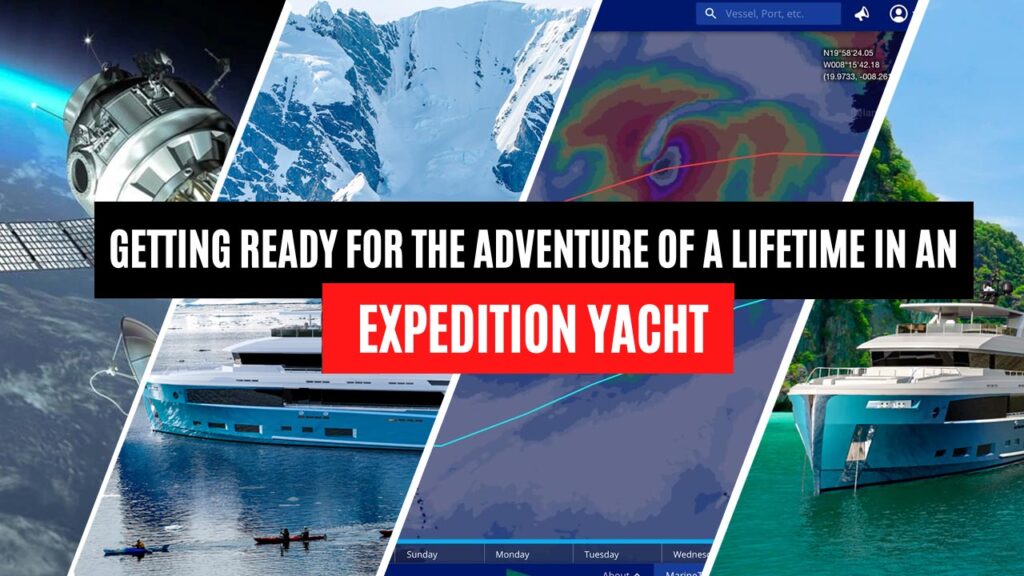Tips for preparing your itinerary and yacht for a voyage to a remote destination.
Explorer yachts are purpose-designed to take their owners on adventures to destinations “off the beaten path”. While they can do everything a traditional motor yacht can do, like transporting you in luxury and comfort to easily accessible cruising grounds in the Caribbean and Mediterranean, they are capable of so much more. With their expansive fuel capacities, efficient propulsion, copious stowage space and seaworthy hull designs, expedition yachts like the Cheoy Lee Explorer Series can help you to fulfill your dreams of voyaging to exotic destinations around the world.
Even with a well-built, steel-hulled bluewater yacht such as a Cheoy Lee Explorer, however, a successful long-range voyage to a remote destination takes careful planning and preparation. Here are some tips for getting ready for an adventure in your expedition yacht.
Plan well in advance
How far in advance to start planning a voyage depends on your destination. Extremely remote regions have far less infrastructure for yachts than regular “milk run” cruising areas. Capt. John Crupi, who took the 146-foot Cheoy Lee expedition yacht Dorothea III to 70 countries on six continents, began planning for some of the more challenging passages on his yacht’s itinerary up to a year in advance.

Consider hiring a weather-routing service
One of the first things to take into consideration is the weather. What is the optimum time of year to take a yacht to your intended destination? For example, the weather in Antarctica is best during summer in the Southern Hemisphere, from November to March, when the temperatures are higher and the days can be up to 24 hours long. Similarly, yachts can only navigate the Northwest Passage through Canada in the Northern Hemisphere’s summer months – and even then, they need to watch out for ice. If your expedition yacht must cross an ocean in order to reach your destination, the best weather window for that passage also must be taken into careful consideration.

The good news is that today, there are a wide variety of sophisticated weather forecasting tools available for expedition yacht owners and captains to consult when planning a long-range voyage. There are government resources such as the U.S. National Weather Service and National Hurricane Center, both provided by the National Oceanic and Atmospheric Administration (NOAA). And there are myriad commercial weather apps and websites to choose from that provide both long- and short-range forecasts.
Experienced mariners like Capt. Crupi often will hire a private marine weather-forecasting service to help with route-planning. Some international meteorological services can offer data on typical weather patterns in a destination region at different times of the year. What’s more, these services can provide daily weather forecasts specific to your yacht’s GPS location for the duration of the voyage. These customized reports can help your captain to avert storms and other dangerous climatic conditions while en route.
Keep the itinerary flexible
Even with the best weather resources at your fingertips, however, when planning a voyage to a remote destination, it’s important to add an extra measure of flexibility. Don't commit to a tight itinerary that requires the yacht to be in a certain port on a certain day as you may encounter unexpected delays. While you might be able to make plans to cruise from Portofino to Monaco on a set schedule during summer season in the Med, navigating a passage to the Arctic or Antarctic with the possibility of ice that could keep the yacht in port for a number of days requires a much looser schedule.
Seek first-hand information
Before you set out for a less-frequented destination, such as Southeast Asia or the Amazon River, that does not have the number or level of fuel bunkering services or fresh-food provisioning options that are available in more popular yachting destinations, it’s important to determine in advance where you are going to find them. The best way to begin researching a particular remote destination is to consult with another yacht owner and/or captain who has voyaged there. That way, you will get first-hand information about the infrastructure in the area, as well as insights into both the challenges and the “can’t miss” experiences you will find there.
Yacht agents that specialize in the region where you plan to voyage in your expedition yacht can be another important resource to tap. Not only can they help to arrange services such as fuel bunkering, but they also can provide invaluable aid with travel visas and other required documentation. A yacht agent also can advise you about potential security threats in the area.
Find a satellite communications provider
Internet connectivity in areas where terrestrial service is spotty or non-existent can be another area of concern for many yacht owners. Today, there are a number of maritime satellite communications companies serving the superyacht community that offer coverage even in the most remote parts of the globe.

Prepare your expedition yacht for self-sufficiency
If you are planning to voyage to a region where few yachts have gone before, it’s important to prepare your expedition yacht to be as self-sufficient as possible. During the planning phase, anticipate any problems you might encounter, such as unstable electrical power, dirty fuel, and rough seas, and equip your yacht to meet them. Its shore power system, fuel-filtration system, watermaker and stabilization system must be equal to any challenges you may face.
Carrying spare parts for the yacht’s vital systems and equipment also can help to make or break a voyage to a remote destination. There may not be a superyacht service yard where you are going. And, unlike in the Med or Caribbean, you might not be able to order a replacement part and have it sent to the yacht via Fedex. Self-sufficiency means your crew will have the parts and skills they need to fix just about anything that might break en route.
If quality provisioning is scarce along your intended itinerary, you also will need to stock the yacht before departure with the food and other supplies you will need for the voyage. It can increase the efficiency of your yacht’s stowage space to make a diagram of where each item will fit on board. This is another area in which the Cheoy Lee Explorer Series excels. The 130 Explorer now under construction, for example, has a full tank deck below the waterline that offers massive dry, refrigerated and freezer stowage.
Preparing for a voyage in an expedition yacht to a remote, untrammeled corner of the globe may be challenging, but if it weren’t, everyone would go there. With careful advance planning and a bit of flexibility, your next yachting adventure will be one you will remember for the rest of your life.




